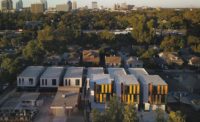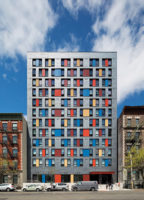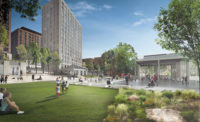Last month in downtown Los Angeles, the El Pueblo emergency homeless shelter opened on a city-owned parking lot near Union Station. Composed of three trailers arranged around a central outdoor deck, El Pueblo is the first of 15 planned “pop-up” shelters to open (one in each city council district), funded through Mayor Eric Garcetti’s “A Bridge Home” program.
Launched in April, the initiative will implement recommendations outlined in a December 2017 report by the nonprofit Urban Land Institute (ULI) to fast-track the construction of “bridge” housing, which provides immediate provisions for homeless individuals until more permanent options become available. According to the mayor’s office, over 25,000 people are now living on the streets of Los Angeles.
In July, the ULI selected three pairings of architecture and landscape architecture firms—DLR Group with EPT Design, SWA with Studio One Eleven, and Realm with JFAK Architects—to develop design prototypes with the mayor’s office. The teams participated in an intensive half-day charrette to create models for 50-, 100-, and 150-bed facilities that could be easily adapted to a number of sites. Although the 45-bed El Pueblo shelter was designed—by Gensler—before the prototypes were developed, it includes many of the same features: outdoor areas, shared resources such as food trucks or community gardens, and modular structures containing beds as well as social services.
The charrette teams worked from a sprung tent typology, along the lines of IKEA’s Better Shelter design for refugees, but “we didn’t want the facilities to look like relief housing,” says ULI’s Los Angeles executive director, Marty Borko. “The goal was to have a modular system that could be arranged to have open space.” According to architect Michael Bohn of Studio One Eleven, who worked with SWA on the 100-bed model, a primary concern was how to integrate the facilities into existing neighborhoods. “We were interested in the mixing zone—the sidewalk where the site meets the street,” says Bohn. One way they aimed to foster a sense of community was by placing a widely appealing amenity at the edge of the project area: a dog park.
Currently, the remaining sites are being identified, with the goal of having all locations at least under construction by July 2019. While the bridge-housing units will not solve the issue of homelessness, Garcetti’s program is a necessary effort to minimize human suffering, says John Maceri, CEO of the People Concern, the nonprofit that operates El Pueblo. “This isn’t about just 45 beds—it’s about the first 45 people and the next 45 people and the next after that, multiplied by dozens of sites around the city,” he says. “It will have a positive impact.”






